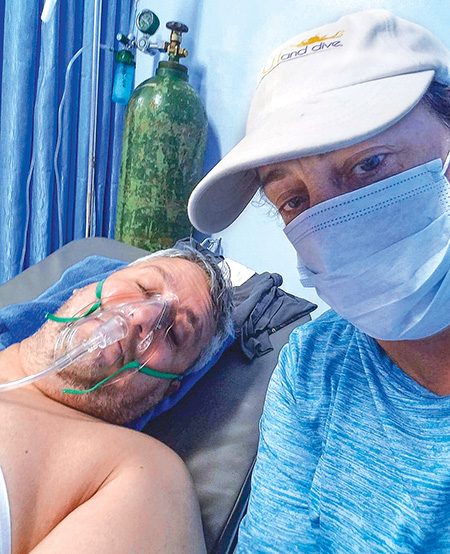During a recent dive trip to Chuuk, I really wanted to see the San Francisco Maru wreck. I never imagined, however, that I would have a near-death experience immediately upon entering the water.
I was in the second group of divers and was on a closed-circuit rebreather (CCR). I jumped in the water and was preparing to start the dive when I took a breath and felt dizzy. After another breath I thought, “I should get back on the boat.” The next thing I remember is waking up on the dive deck with people trying to jam a regulator in my mouth and get me on emergency oxygen.
A diver on the boat who was directly involved in the rescue kept a timeline that showed I was nonresponsive with my jaw locked five minutes after the entry. Once I was hauled onto the deck, my pulse was weak, my bowels released, I was completely limp and turning blue, and I had white sputum. Other divers forced open my jaw so they could get oxygen in, and I started showing signs of breathing 20 minutes after the entry.
After being moved inside, I was nauseous and sensitive to light, and my sternum felt tight. An hour and 40 minutes after I entered the water, I was at the hospital. My blood oxygen level was 89 percent, and I was on oxygen and a sodium chloride IV until it was back to 96 percent. After medical staff did an EKG and a chest X-ray, I could soon stand again and walk on my own, but I was drowsy and cold and had a mild headache. When I was cleared to leave the hospital, I went to a hotel near the airport and rested until it was time to go home.
After the incident I had time to reflect on what happened and why. I had sent my CCR for annual service before the trip. Technicians replaced oxygen sensors, hoses, and O-rings, serviced the first stages, and installed the latest upgrade to the unit. I did not dive with the newly serviced unit before the trip, which was my first error.
I put together the unit when we got on board the dive boat and performed all the necessary checklist items. My computer was not connecting to the unit, but it worked after I disconnected the cable, wiped the connectors, and reconnected everything. This problem recurred several times during the week, but I kept an eye on it, and everything was OK for the first five days of the trip. I was taught to never start a dive with a known issue, but I did it anyway, which was my second error.

Then came the morning of the dive. The first group splashed in, followed by my dive buddy. Seeing my buddy in the water waiting for me, I started to rush, which was my third error and when things really started to go wrong. I opened the oxygen and diluent valves, verified my bailout was on, and checked my inflator. I put my loop in my mouth, went to the dive deck, and jumped in the water.
My fourth and final error was that I did not verify that my solenoid was firing. The computer was not connecting to the unit, and the solenoid would not fire. In my rush to get in the water, I did not manually add oxygen or notice my dropping partial pressure of oxygen (PO2). I breathed the PO2 in my loop down to a level that would not support life.
My buddy called for help and dragged me to the diver lift. The other divers on the boat pried open my jaws and forced as much oxygen as they could into my system until I started breathing again. They got me out of my gear and to the hospital as fast as possible.
This incident occurred on a CCR, but open-circuit divers also need to be diligent with their dive planning and predive preparations. Many things can go wrong with your equipment, and skipping vital predive checks can lead to fatal consequences.
The only things that saved me from becoming a line on a diver fatality data spreadsheet were that I had inflated my wing more than usual (since I had extra bailout) and the actions of the other divers on the boat. Had I been negatively buoyant when I went in the water or had my buddy and the other divers not been attentive, I would not be alive today.
When I got home I sent the unit back to the factory. They replaced the computer and thoroughly checked the unit. Once they verified everything was operational, I took it on a few dives. My predive checklist was comprehensive, and I verified my solenoid was operating and that all systems were working correctly before entering the water.
I always remember the lessons I learned from this incident when doing predive planning and checklists. If it takes me five more minutes to get in the water, so be it. Complacency can kill you if given the opportunity, and there may be little or no warning. It seems so obvious now that I should have dropped my bailout from my mouth and taken a breath of air, but after that first dizzying breath from my loop I was incapable of any clear thought.
All the training, all the skills practice, and all the thoughts that it would never happen to me meant nothing. Don’t let it happen to you. The other divers involved have my eternal gratitude for saving my life.
© Alert Diver — Q2 2024